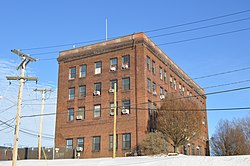Wheeling and Lake Erie Railway (1990)
This article includes a list of general references, but it remains largely unverified because it lacks sufficient corresponding inline citations. (May 2018) |
| Overview | |
|---|---|
| Reporting mark | WE |
| Locale | Ohio, Pennsylvania, Maryland, West Virginia |
| Dates of operation | 1990– |
| Predecessor | Norfolk and Western Railway |
| Technical | |
| Track gauge | 4 ft 8+1⁄2 in (1,435 mm) standard gauge |
| Length | Owned: 575 miles (925 km) Rights: 265 miles (426 km) |
| Other | |
| Website | www |
The Wheeling and Lake Erie Railway (reporting mark WE) is a Class II regional railroad that provides freight service, mainly in the U.S. state of Ohio. It took its name from the former Wheeling and Lake Erie Railway, most of which it bought from the Norfolk and Western Railway in 1990.
History[]
1880-1949[]
The W&LE Railroad began standard gauge operations under investor Jay Gould in 1880. Its mainline ran from Wheeling to Zanesville to Cleveland, and it ran freight and passenger trains primarily between those cities. Passenger service ended in 1940 just before the start of WW2. In 1949, the New York, Chicago, & St. Louis Railroad, or Nickel Plate Road as it was known, leased the W&LE. In 1964, the Nickel Plate combined with the Norfolk and Western RR.[1]
1964-present day[]
In 1990, the Norfolk and Western Railway, a subsidiary of the Norfolk Southern Railway, sold portions of its lines in Ohio and Pennsylvania, including most of the lines of the former W&LE and the Akron, Canton and Youngstown Railroad, as well as a lease on the Pittsburgh and West Virginia Railroad, to the Wheeling Acquisition Corporation. The name was changed to the Wheeling and Lake Erie "Railway" in May, before operations began. At its formation, trackage rights on Norfolk Southern were extended to the new organization to serve several limestone quarries in the Bellevue, Ohio area, and trackage rights with CSX Transportation from Connellsville, Pennsylvania to Hagerstown, Maryland, this being a remnant of the 1950s Alphabet Route of which the original W&LE was a part. W&LE Ry also maintains trackage rights from Wellington to Cleveland on CSX.
The only portions of the original W&LE operated by companies other than the current W&LE are the NS line west of Bellevue (W&LE now has trackage rights to Toledo on this line, obtained after the Conrail split in 1999); the former Cleveland Division line south of Harmon (Brewster) that was sold to Ohio Central Railroad by NS in 1988; and the Huron docks trackage. The Huron Branch, W&LE's first line between Norwalk and Huron, was acquired by W&LE but was never activated north of the Norwalk city limits and was later removed in its entirety. W&LE still serves the Huron Docks using trackage rights on NS's former Nickel Plate Road line from Bellevue and a connecting line to the docks built by the NKP in 1952. A few other small portions of the original W&LE and AC&Y have been abandoned and/or replaced with trackage rights on parallel lines by W&LE.
System[]

W&LE also has trackage rights to Lima, Ohio, that originally used CSX lines from Carey to Upper Sandusky to Lima, but after the lease of the CSX line (the former Pennsylvania Railroad Fort Wayne Line) by RailAmerica's Chicago, Fort Wayne and Eastern Railroad, W&LE now uses trackage rights from its lines at New London to Crestline, Ohio on CSX, then west on the CF&E to Lima. These trackage rights were also a result of the Conrail split.
W&LE lines interchange with three major Class I railroads (Canadian National Railway, CSX Transportation, and the Norfolk Southern Railway). Many of the major commodities remain the same as in the early days: coal from southeastern Ohio; iron ore from the Great Lakes region; steel from five different mills; aggregates from four quarries; plus chemicals, forest products, and grain, generating approximately 130,000 carloads annually.
Branch lines reach as far south as Benwood, West Virginia (just south of Wheeling) and as far east as Connellsville, Pennsylvania. The W&LE joins the Southwest Pennsylvania Railroad at Owensdale, Pennsylvania. The W&LE currently owns 575 miles (925 km) of track and retains trackage rights on another 265 miles (426 km).[2]
References[]
General references[]
- Corns, John B. (1991). The Wheeling and Lake Erie Railway, Volume 1. Lynchburg, Virginia: TLC Publishing Company. ISBN 0-9622003-5-2.
- Corns, John B. (2002). The Wheeling and Lake Erie Railway, Volume 2. Lynchburg, Virginia: TLC Publishing Company. ISBN 1-883089-75-1.
- Rehor, John A. (1994) [1965]. The Nickel Plate Story. Waukesha, Wisconsin: Kalmbach Publishing Co.
- "History". Wheeling and Lake Erie Railway. Retrieved 2008-07-28.
- "System map". Wheeling and Lake Erie Railway. Retrieved 2017-01-13.
- "WE Wheeling & Lake Erie Railway". CSX Transportation. Retrieved 2008-07-28.
- "Wheeling and Lake Erie RR details". Norfolk Southern Railway Short Lines - Ohio. Retrieved 2008-07-28.
- "Wheeling and Lake Erie RR system map". . Retrieved 2013-05-01.
External links[]
 Media related to Wheeling and Lake Erie Railway (1990) at Wikimedia Commons
Media related to Wheeling and Lake Erie Railway (1990) at Wikimedia Commons- Wheeling and Lake Erie Railway
- Regional railroads in the United States
- Ohio railroads
- West Virginia railroads
- Pennsylvania railroads
- Maryland railroads
- Railway companies established in 1990
- Spin-offs of the Norfolk Southern Railway
- Companies operating former Baltimore and Ohio Railroad lines
- Companies operating former New York, Chicago and St. Louis Railroad lines
- Companies operating former Norfolk and Western Railway lines
- Rail transportation in Cleveland
- American companies established in 1990